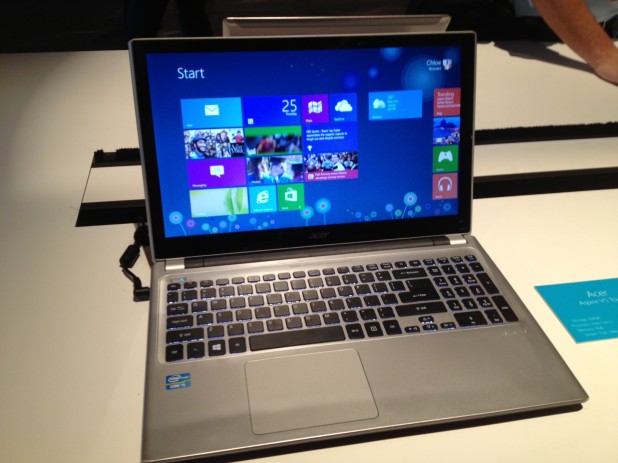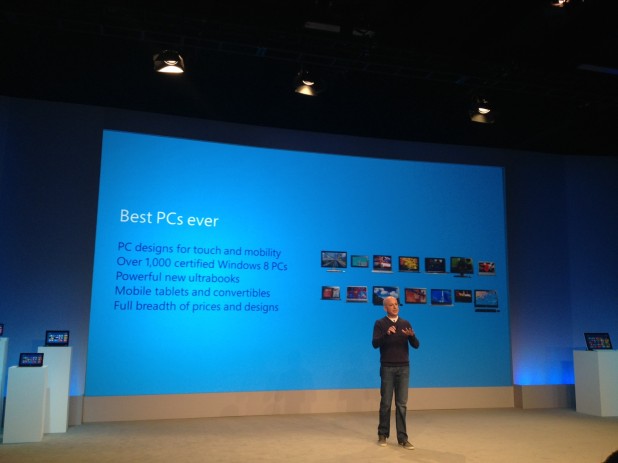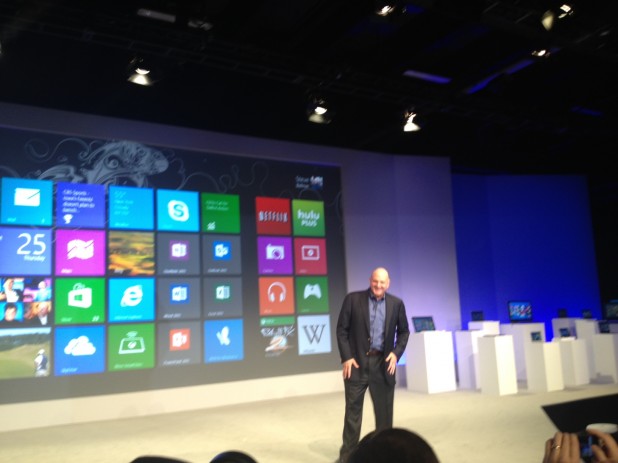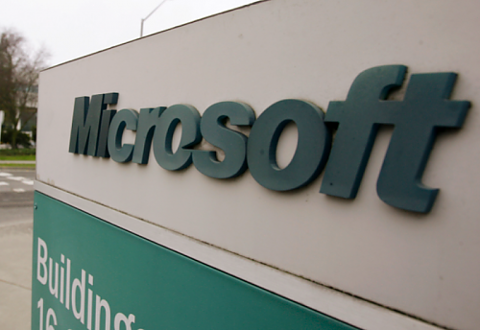[caption id="attachment_5452" align="alignleft" width="618"]

A PC at Microsoft's launch event running Windows 8.[/caption] NEW YORK—Windows division president Steven Sinofsky took to a stage in New York City to officially launch Windows 8, Microsoft’s latest operating system and its big hope for taking a piece of the mobile-device market away from Apple and Google. From the moment the user first boots a Windows 8 device, it’s clear that Microsoft has radically changed how it thinks about operating systems. In place of the “old school” Windows desktop,
Windows 8’s Start screen is a mosaic of colorful tiles, each of them linked to a particular application. A desktop interface is still accessible, but only by clicking or tapping one of those tiles.

Sinofsky termed Windows 8 the beginning of a “new era of Windows” and the devices running it "the best PCs ever made," the latter something the hardware people over at Apple might take issue with. Microsoft’s reasoning for the dual interface goes something like this: the tap- and swipe-happy tile interface (previously known as Metro, before Microsoft got involved in a weird copyright issue over the term) is ideal for mobile devices such as tablets. Placing Windows 8 on tablets will allow Microsoft to challenge the iPad and plethora of Google Android devices currently drawing all the attention and profits in the burgeoning mobile arena. Meanwhile, the underlying desktop is available for power users and traditionalists. Windows 8, in other words, is trying to be all things to all people. But can it succeed? A lot hinges on whether Microsoft can attract third-party developers to build apps for the Windows Store, the Windows 8 app storefront. Without a healthy app ecosystem, any mobile device will have a harder time attracting users (especially considering how the Apple and Google app storefronts boast hundreds of thousands of apps). But the operating system’s success will also hinge on everything from hardware price-points to whether Microsoft can persuade businesses to upgrade. In his keynote, Sinofsky alluded to the app store and what some might perceive as a lack of apps. "People must rush to count apps," he said. "We count today as a grand opening and a very solid one." The Windows Store, he added, "has more apps than any competing app store had at its opening." Microsoft is also launching Windows RT, a version of Windows 8 built to run on devices powered by ARM architecture, which dominates the mobility segment. While Windows RT looks exactly like Windows 8, it won’t run the legacy programs built for Windows on x86 processors. Microsoft and its hardware partners will need to make that difference (and others) clear to consumers and businesses,
lest it risk some blowback. Sinofsky was up front about the lack of compatibility between Windows RT and older versions of Windows. "It doesn’t run programs designed for Windows 7," he said. "It runs a suite of built-in apps." But he was also speaking to the tech press; it remains to be seen whether Microsoft makes that sort of push in its advertising and in actual stores. While Microsoft has expanded its product portfolio over the years, Windows remains a considerable revenue driver. Windows 7 has sold hundreds of millions of licenses over the past three years, buoying Microsoft’s bottom line at a time when its other initiatives—most notably mobile and the cloud—have failed to generate substantial revenue. And that’s the challenge facing Windows 8. If the operating system and its associated hardware capture the attention (and dollars) of mobile-device users, Microsoft will have successfully expanded the Windows brand to a new and rapidly growing market segment. But if it fails, and Apple and Google continue to rule the mobility space, then Microsoft is left with few alternatives. Over the past few years, consumers have increasingly shifted their computing center of gravity from desktops and laptops to mobile devices such as tablets and desktops; Microsoft will still dominate the operating-system market for the former, but that market also isn’t what it used to be. Near the end of Microsoft’s New York presentation, CEO Steve Ballmer appeared onstage. “One device now pairs the greatest qualities of the PC with the greatest qualities of the tablet experience,” he told the audience. Microsoft is hoping that millions of people will agree.

 A PC at Microsoft's launch event running Windows 8.[/caption] NEW YORK—Windows division president Steven Sinofsky took to a stage in New York City to officially launch Windows 8, Microsoft’s latest operating system and its big hope for taking a piece of the mobile-device market away from Apple and Google. From the moment the user first boots a Windows 8 device, it’s clear that Microsoft has radically changed how it thinks about operating systems. In place of the “old school” Windows desktop, Windows 8’s Start screen is a mosaic of colorful tiles, each of them linked to a particular application. A desktop interface is still accessible, but only by clicking or tapping one of those tiles.
A PC at Microsoft's launch event running Windows 8.[/caption] NEW YORK—Windows division president Steven Sinofsky took to a stage in New York City to officially launch Windows 8, Microsoft’s latest operating system and its big hope for taking a piece of the mobile-device market away from Apple and Google. From the moment the user first boots a Windows 8 device, it’s clear that Microsoft has radically changed how it thinks about operating systems. In place of the “old school” Windows desktop, Windows 8’s Start screen is a mosaic of colorful tiles, each of them linked to a particular application. A desktop interface is still accessible, but only by clicking or tapping one of those tiles.  Sinofsky termed Windows 8 the beginning of a “new era of Windows” and the devices running it "the best PCs ever made," the latter something the hardware people over at Apple might take issue with. Microsoft’s reasoning for the dual interface goes something like this: the tap- and swipe-happy tile interface (previously known as Metro, before Microsoft got involved in a weird copyright issue over the term) is ideal for mobile devices such as tablets. Placing Windows 8 on tablets will allow Microsoft to challenge the iPad and plethora of Google Android devices currently drawing all the attention and profits in the burgeoning mobile arena. Meanwhile, the underlying desktop is available for power users and traditionalists. Windows 8, in other words, is trying to be all things to all people. But can it succeed? A lot hinges on whether Microsoft can attract third-party developers to build apps for the Windows Store, the Windows 8 app storefront. Without a healthy app ecosystem, any mobile device will have a harder time attracting users (especially considering how the Apple and Google app storefronts boast hundreds of thousands of apps). But the operating system’s success will also hinge on everything from hardware price-points to whether Microsoft can persuade businesses to upgrade. In his keynote, Sinofsky alluded to the app store and what some might perceive as a lack of apps. "People must rush to count apps," he said. "We count today as a grand opening and a very solid one." The Windows Store, he added, "has more apps than any competing app store had at its opening." Microsoft is also launching Windows RT, a version of Windows 8 built to run on devices powered by ARM architecture, which dominates the mobility segment. While Windows RT looks exactly like Windows 8, it won’t run the legacy programs built for Windows on x86 processors. Microsoft and its hardware partners will need to make that difference (and others) clear to consumers and businesses, lest it risk some blowback. Sinofsky was up front about the lack of compatibility between Windows RT and older versions of Windows. "It doesn’t run programs designed for Windows 7," he said. "It runs a suite of built-in apps." But he was also speaking to the tech press; it remains to be seen whether Microsoft makes that sort of push in its advertising and in actual stores. While Microsoft has expanded its product portfolio over the years, Windows remains a considerable revenue driver. Windows 7 has sold hundreds of millions of licenses over the past three years, buoying Microsoft’s bottom line at a time when its other initiatives—most notably mobile and the cloud—have failed to generate substantial revenue. And that’s the challenge facing Windows 8. If the operating system and its associated hardware capture the attention (and dollars) of mobile-device users, Microsoft will have successfully expanded the Windows brand to a new and rapidly growing market segment. But if it fails, and Apple and Google continue to rule the mobility space, then Microsoft is left with few alternatives. Over the past few years, consumers have increasingly shifted their computing center of gravity from desktops and laptops to mobile devices such as tablets and desktops; Microsoft will still dominate the operating-system market for the former, but that market also isn’t what it used to be. Near the end of Microsoft’s New York presentation, CEO Steve Ballmer appeared onstage. “One device now pairs the greatest qualities of the PC with the greatest qualities of the tablet experience,” he told the audience. Microsoft is hoping that millions of people will agree.
Sinofsky termed Windows 8 the beginning of a “new era of Windows” and the devices running it "the best PCs ever made," the latter something the hardware people over at Apple might take issue with. Microsoft’s reasoning for the dual interface goes something like this: the tap- and swipe-happy tile interface (previously known as Metro, before Microsoft got involved in a weird copyright issue over the term) is ideal for mobile devices such as tablets. Placing Windows 8 on tablets will allow Microsoft to challenge the iPad and plethora of Google Android devices currently drawing all the attention and profits in the burgeoning mobile arena. Meanwhile, the underlying desktop is available for power users and traditionalists. Windows 8, in other words, is trying to be all things to all people. But can it succeed? A lot hinges on whether Microsoft can attract third-party developers to build apps for the Windows Store, the Windows 8 app storefront. Without a healthy app ecosystem, any mobile device will have a harder time attracting users (especially considering how the Apple and Google app storefronts boast hundreds of thousands of apps). But the operating system’s success will also hinge on everything from hardware price-points to whether Microsoft can persuade businesses to upgrade. In his keynote, Sinofsky alluded to the app store and what some might perceive as a lack of apps. "People must rush to count apps," he said. "We count today as a grand opening and a very solid one." The Windows Store, he added, "has more apps than any competing app store had at its opening." Microsoft is also launching Windows RT, a version of Windows 8 built to run on devices powered by ARM architecture, which dominates the mobility segment. While Windows RT looks exactly like Windows 8, it won’t run the legacy programs built for Windows on x86 processors. Microsoft and its hardware partners will need to make that difference (and others) clear to consumers and businesses, lest it risk some blowback. Sinofsky was up front about the lack of compatibility between Windows RT and older versions of Windows. "It doesn’t run programs designed for Windows 7," he said. "It runs a suite of built-in apps." But he was also speaking to the tech press; it remains to be seen whether Microsoft makes that sort of push in its advertising and in actual stores. While Microsoft has expanded its product portfolio over the years, Windows remains a considerable revenue driver. Windows 7 has sold hundreds of millions of licenses over the past three years, buoying Microsoft’s bottom line at a time when its other initiatives—most notably mobile and the cloud—have failed to generate substantial revenue. And that’s the challenge facing Windows 8. If the operating system and its associated hardware capture the attention (and dollars) of mobile-device users, Microsoft will have successfully expanded the Windows brand to a new and rapidly growing market segment. But if it fails, and Apple and Google continue to rule the mobility space, then Microsoft is left with few alternatives. Over the past few years, consumers have increasingly shifted their computing center of gravity from desktops and laptops to mobile devices such as tablets and desktops; Microsoft will still dominate the operating-system market for the former, but that market also isn’t what it used to be. Near the end of Microsoft’s New York presentation, CEO Steve Ballmer appeared onstage. “One device now pairs the greatest qualities of the PC with the greatest qualities of the tablet experience,” he told the audience. Microsoft is hoping that millions of people will agree. 
